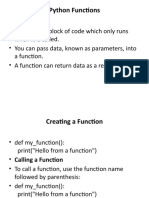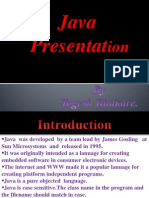Python Unit - 4
Uploaded by
SATHISHKUMARPython Unit - 4
Uploaded by
SATHISHKUMARUNIT – 4 Example:
Functions and Functional Programming – Functions – calling functions
– creating functions – passing functions – Built-in Functions: apply( ),
filter( ), map( ) and reduce( ) - Modules – Modules and Files – Modules
built-in functions - classes – class attributes – Instances.
FUNCTION
Function is a block of code.
A large program divided into small program is called Output:
function.
Function is defined using the def keyword.
CREATING FUNCTION
The functions create using the keyword def.
Function must end with the colon (:).
Keyword cannot be used as function name.
Function name followed by the parenthesis ().
Parenthesis is used to pass the parameter or argument.
Syntax:
def function_name ():
#statement
V. Naresh Kumar, M.C.A., M.Phil., Page 1
CALLING FUNCTIONS PASSING FUNCTIONS
Here, passing some value as a parameter to the function.
To call a function, use the function name followed by
Syntax:
parenthesis:
Function_name (Parameter)
Syntax:
Example:
Function_name ()
Example:
Output:
Output:
V. Naresh Kumar, M.C.A., M.Phil., Page 2
BUILT-IN FUNCTIONS 2. filter ()
1. map() The filter() function in Python filters elements from an
Python's map() method applies a specified function to each iterable based on a given condition or function.
item of an iterable (such as a list, tuple, or string). And returns a new iterable with the filtered elements.
Then returns a new iterable containing the results. Syntax:
Syntax: filter(function, iterable)
map (function, iterable) Here also, the first argument passed to the filter function is
The first argument passed to the map function is itself a itself a function.
function. And the second argument passed is an iterable (sequence of
The second argument passed is an iterable (sequence of elements) such as a list, tuple, set, string, etc.
elements) such as a list, tuple, set, string, etc. Example:
Example: data = [1, 2, 3, 4, 5]
data = [1, 2, 3, 4, 5]
evens = filter(lambda x: x % 2 == 0, data)
squares = map(lambda x: x*x, data)
for i in squares: for i in evens:
print(i, end=" ") print(i, end=" ")
squares = list(map(lambda x: x*x, data)) evens = list(filter(lambda x: x % 2 == 0, data))
print(f"Squares: {squares}")
print(f"Evens = {evens}")
V. Naresh Kumar, M.C.A., M.Phil., Page 3
3. reduce()
Given function to the elements of an iterable, reducing them
to a single value.
Syntax:
reduce(function, iterable[,initializer])
The function argument is a function that takes two arguments
and returns a single value.
The first argument is the accumulated value.
The second argument is the current value from the iterable.
Example:
from functools import reduce
def add(a, b):
return a + b
num_list = [1, 2, 3, 4, 5, 6, 7, 8, 9, 10]
as the second argument
sum = reduce(add, num_list)
print(f"Sum of the integers of num_list : {sum}")
sum = reduce(add, num_list, 10)
print(f"Sum of the integers of num_list with initial value 10 :
{sum}")
V. Naresh Kumar, M.C.A., M.Phil., Page 4
MODULES AND FILES IN PYTHON Create packages:
Python file has the extension of “.py”. Contains the __init__.py
Module provides the reusable codes. Contain initialization code for the package.
Example Example package structure:
Creating Module: my_package/
# File: my_module.py __init__.py
def greet(name): module1.py
print("Hello, {}!".format(name)) To import modules from a package,
def square(x): import my_package.module1
return x ** 2 from my_package import module2
pi = 3.14159 my_package.module1.function ()
module2.function ()
Importing module:
import my_module Imports within a package using dot notation:
my_module.greet("Alice") # Output: Hello, Alice! from . import module1
print(my_module.square(5)) # Output: 25 from .module2 import function module2.py
print(my_module.pi) # Output: 3.14159
Import specific functions or variables from the module:
from my_module import greet, square
greet("Bob") # Output: Hello, Bob!
print(square(3)) # Output: 9
V. Naresh Kumar, M.C.A., M.Phil., Page 5
MODULES BUILT-IN FUNCTIONS 11. open ():
Opens a file and returns a file object.
1. Print ():
12. input ():
Prints the given object to the standard output.
Reads a line of input from the standard input (usually the
2. len():
keyboard).
Returns the length (number of items) of an object such as a
14. enumerate ():
string, list, tuple, etc.
Returns an enumerate object that yields pairs of indices and
3. input():
values from an iterable.
Reads input from the user through the console.
15. zip():
4. int(), float(), str(), bool():
Returns an iterator that aggregates elements from multiple
Convert the given value to an integer, floating-point number,
iterables.
string, or boolean, respectively.
5. range():
Generates a sequence of numbers.
6. type():
Returns the type of an object.
7. max(), min():
Returns the maximum or minimum value from a sequence or
set of arguments.
8. sum():
Returns the sum of all elements in a sequence.
9. abs():
Returns the absolute value of a number.
10. round():
Rounds a number to a specified number of decimal places.
V. Naresh Kumar, M.C.A., M.Phil., Page 6
CLASS ATTRIBUTE & INSTANCE Program Explanation:
Class attributes are attributes that are associated with a class class_attribute is a class attribute.
rather than with instances (objects) of the class. instance_attribute is an instance attribute.
They are shared among all instances of the class. Class attributes are accessed using the class name
Class attributes are defined within the class definition but (MyClass.class_attribute)
outside of any methods.
Example:
class MyClass:
class_attribute = 10
def __init__(self, instance_attribute):
self.instance_attribute = instance_attribute
print(MyClass.class_attribute)
obj1 = MyClass(20)
obj2 = MyClass(30)
print(obj1.instance_attribute)
print(obj2.instance_attribute)
print(obj1.class_attribute)
print(obj2.class_attribute)
obj1.class_attribute = 100
print(obj1.class_attribute)
print(MyClass.class_attribute)
MyClass.class_attribute = 200
print(obj2.class_attribute)
V. Naresh Kumar, M.C.A., M.Phil., Page 7
You might also like
- Important (Python Built-In Methods) (CheatSheet)No ratings yetImportant (Python Built-In Methods) (CheatSheet)6 pages
- Python Unit - 2 Functions, Exception and FILES - MCANo ratings yetPython Unit - 2 Functions, Exception and FILES - MCA65 pages
- Exploring Python Functions Reading - FunctionsNo ratings yetExploring Python Functions Reading - Functions9 pages
- Python-FUNCTIONS by Vivek Singh Khetwal.No ratings yetPython-FUNCTIONS by Vivek Singh Khetwal.10 pages
- User Defined Functions in Python Chapter 2 (1)No ratings yetUser Defined Functions in Python Chapter 2 (1)16 pages
- Understanding The 10 Most Difficult Python Concepts - by Joanna - Geek CultureNo ratings yetUnderstanding The 10 Most Difficult Python Concepts - by Joanna - Geek Culture24 pages
- Cembrano, Stephanie Rei Allana S. DICT 2-1 Quiz 1No ratings yetCembrano, Stephanie Rei Allana S. DICT 2-1 Quiz 14 pages
- Properties (C# Programming Guide) - Microsoft DocsNo ratings yetProperties (C# Programming Guide) - Microsoft Docs14 pages

























































































